09/11/2017
QUERIES (CLINCAL)
Query: Lymphedema and Filariasis
My patent is a 53 year old white male, paraplegic from MVA 10 years ago. He has a 4-year history of swelling and deformity of his toes bilaterally. He lived in the South American jungles from 1996 to 2005 doing surveillance/DEA type work.
 |
Lymphedema and Filariasis |
His legs are both swollen with a history of DVT, and he is on warfarin. I came up with a diagnosis of lymphedema and filariasis. He has had no treatment for this condition. I am looking for additional information about diagnosis and treatment.
09/14/2013
QUERIES (CLINCAL)
My patient, a 42 year old female, presented with edema bilaterally, which began 3 months ago and does not change during the day or night. BP and Doppler assessment of circulation were normal. Her MD has done blood tests for: liver enzymes, kidney, thyroid etc., all were normal. Due to the edema, there is stiffness in joints: ankle, MPJs, etc. Recently a rash has started. She has worn support hose with limited success. She does not take medicines or have any known allergies.
 |
Bilateral constant edema with rash |
Any ideas that I could pass on to patient to ask her MD to perform (tests/further assessments)? I suspected Lyme disease, but it is rare in Toronto. There was no history of tick bites or the characteristic bullseye.
09/13/2013
QUERIES (CLINCAL)
Query: RF Ablation for Heel Pain
I have written previously about a patient with severe pain S/P a plantar fasciotomy. A local nerve block confirms the nerve origin of his pain. We are considering radio frequency ablation. Have any of my colleagues used this treatment for local nerve origin heel pain, and if so, how successful was it?
Mark Aldrich, DPM, Antigo, WI
09/11/2013
QUERIES (CLINCAL)
Query: Effective Treatment for Hyperhidrosis
I'm looking for "pearls" or treatments of hyperhidrosis. I recommended antiperspirants and Drysol, but I'm looking for something actually effective for these patients.
Billie A. Bondar, DPM, Rochester, NH
08/30/2013
QUERIES (CLINCAL)
Query: Bunion With Overlapping 2nd Toe
The patient is a 43 year old female resident in a nursing facility. She is a former heroin user who has pain upon ambulation and difficulty wearing shoes. She has a callus submetatarsal 2. My first instinct was to amputate the second toe and address the bunion with an Austin, but the patient is totally against amputation. She doesn't walk around a lot in the nursing home.
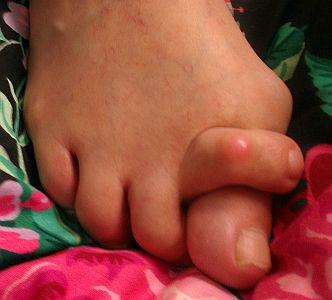 |
Bunion With Overlapping 2nd Toe |
If I could trust her, I might consider a base wedge and head procedure, but I don't trust her to not bear weight, and she is really not able to use crutches (she suffered a brain injury when she was shot two years ago). I may try to do a 2nd met head resection and pin the toe, along with an Austin. Any suggestions?
08/29/2013
QUERIES (CLINCAL)
Query: Hyperkeratotic Lesions
A 25 year-old female presents with out-of-proportion pain, lesions submetatarsal 2-4 and plantar central heel right foot which she has had for 6 years. I treated her five years ago with surgical excision (path report: hyperkeratosis) but she was non-compliant and disappeared prior to the end of her post-op course. Her PCP referred her back to me one week ago. The lesions look the same except for the heel. It was surgically excised by an unknown surgeon who performed a split-thickness skin graft two years ago.
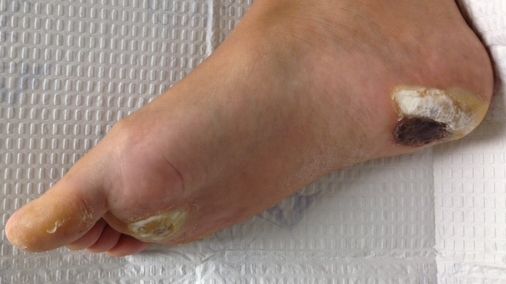 |
Hyperkeratotic Lesions |
The lesions are intermittent and the triggers are unknown. She stopped drinking alcohol because it worsened the pain. She has visited a pain specialist without success and has minimal relief with ice foot soaks, narcotics, and ibuprofen. I recommended a dermatologist but there isn't one in the vicinity who takes her insurance. Suggestions?
08/28/2013
QUERIES (CLINCAL)
Query: PT Course After EHL Repair
My patient is a 17 year old female who dropped a kitchen knife on her bare foot, lacerating the EHL tendon and penetrating the joint capsule into the 1st MPJ. She received antibiotics and tetanus prophylaxis at the hospital and the skin laceration was sutured. She was unable to dosiflex the big toe afterwards. I surgically repaired the capsule and tendon about 5 days after the original injury.
 |
EHL Repair |
I repaired the capsule with Vicryl, and for the tendon used two Bunnel sutures of fiberwire which I tied for good apposition. The tendon did not retract very far. The tendon sheath was not repairable. What's a reasonable PT course for a 17 year old? She plays soccer and would like to return in the spring. One therapist wants to start 2 weeks post-op; the other wants to start at 6 weeks.
08/23/2013
QUERIES (CLINCAL)
Query: Traumatized Hallux Nail in 9 Year Old
A 9 year old boy was brought to my office having traumatically lost his hallux nail 2 years prior, after dropping a large rock on it. At that time, no medical care was sought. The nail re-grew abnormally. He now has intermittent pain in the hallux interphalangeal joint, which mom thinks is from the deformed toe nail. The boy thinks the nail is cosmetically “ugly” but pain-free. It is obvious that the traumatized toe is larger than the non-injured toe, and questioning shows this to have been a gradual deformity since the injury.
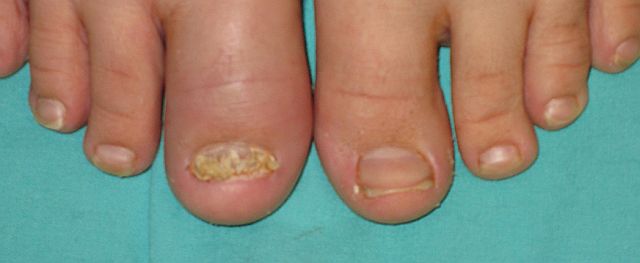 |
Traumatized Hallux Nail in 9 Year Old |
X-rays show normal bone but the outline of the enlarged toe is apparent. The joints appear normal. There is no limitation of motion or crepitus or pain. All labs including rheumatoid and ANA work-ups are normal with an ESR of 30 (normal high is 15). Although a growth plate injury can stimulate bone growth, this appears to be primarily soft tissue. I am considering an MRI to see if I can visualize any damaged cartilage. Any other suggestions?
David E. Gurvis, DPM, Avon, IN
08/22/2013
QUERIES (CLINCAL)
Query: Wart Treatments
I have used Cantharidin in the office for plantar warts for years with great results. I’m now finding it impossible to order this in the U.S. In the past, I have used freezing, podophylin, and salicylic acid with less than optimal results. I’m interested in hearing what others are using with good results.
Theresa M. Hughes, DPM, Galesburg, IL
08/20/2013
QUERIES (CLINCAL)
Query: Silver as an Anti-Fungal?
Several of my patients are using silver gel or silver solution to treat their tinea pedis and onychomycosis. These people have been refractory to typical topical antifungal treatments, and all have been verified with positive fungal cultures. I have also witnessed an improvement. Has anyone else seen similar results? Is the mechanism of action the same for silver's anti-microbial properties?
David Weiss, DPM, Richmond, VA
08/16/2013
QUERIES (CLINCAL)
Query: Bulbous Toes Bilaterally
This active young female patient presented with bilateral bulbous 3rd/4th toes. The DIPJ is mildly contracted, but the ends of the toes are otherwise quite "bulbous." They get very red, cracked, and painful at the skin fold.
 |
Bulbous Toes Bilaterally |
I have dispensed a gel buttress pad for her to try. Other than surgery, any thoughts on treatment?
David Kahan, DPM, Sacramento, CA
08/15/2013
QUERIES (CLINCAL)
Query: Popliteal Block for Forefoot Surgery
Typically, I try to use a popliteal block for challenging rear foot cases or cases in which I need muscle paralysis combined with sedation delivered by an anesthesiologist. For forefoot cases, I typically use an ankle block and sedation. Due to the clinical response of longer pain relief that I see with popliteal blocks, I am considering performing more forefoot surgeries under this anesthesia. I cannot recall reading any research comparing ankle blocks with popliteal blocks for forefoot surgeries. What experiences have others had?
Tip Sullivan, DPM, Jackson, MS
08/14/2013
QUERIES (CLINCAL)
Query: Non-union Following a Lapidus Procedure
I carried out this procedure on a healthy 40 year old female 11 months ago. She has no discomfort, the medial arch is stable and she has returned to some gym work. I have concerns, however, as there is no sign of bony union and a clear gap is seen. I have fully advised the patient of this and have explained that the stability is only being maintained by the metalwork. The patient declines further surgery stating that she is content.
I have mentioned the possibility of a bone stimulator. Does anyone have experience with this equipment, bearing in mind the time lag? I am reluctant to leave things as they are without exploring every avenue.
Barry Francis, Consultant podiatric Surgeon, London, UK
08/13/2013
QUERIES (CLINCAL)
Query: Severe Heel Pain After Plantar Fasciotomy
My patient is a 46-y/o, non-smoking, healthy man. He was treated with orthotics in the past with limited success for mid-central plantar fascial pain of the left foot. He then underwent several injections which failed to remedy the problem. He subsequently had a plantar fasciotomy performed February 2013 with resulting severe, persisting plantar left heel pain whenever weight-bearing. He was subsequently treated with immobilization and non-weight-bearing for several weeks, and a steroid injection in May. He also tried chiropractic treatment and acupuncture, all to no avail. He has found temporary improvement with reflexology massage. He currently takes Vicodin and Lyrica with very little, temporary relief. There are no atrophic/CRPS changes in the left foot.
He came to me recently with severe pain on palpation at the plantar fascial origin and plantar medially at the heel. Radiographs were negative for bone changes. Recent MRIs demonstrated thickening of the plantar fascia at the heel, along with some slight edema within the plantar calcaneus, but no evidence of stress fracture, abscess, or bone infection. I'm seeking any suggestions.
Mark Aldrich DPM, Antigo, WI
08/10/2013
QUERIES (CLINCAL)
Query: Conservative Care for Subluxing Peroneals
Does anyone have some tips for treating non-painful subluxing peroneal tendons in an eight year old child?
Susan Papp-Mlodzienski, DPM, Philadelphia, PA
08/02/2013
QUERIES (CLINCAL)
Query: Freiberg's Infraction in a 14 Year Old
I have a young 14 y/o female who is active in cheerleading and tumbling. We have diagnosed her with Freiberg's Infraction based on clinical and MRI findings. I have her in a cast for 3 weeks, but I have explained that, in some cases, this could essentially end her athletics. I want her to take the treatment seriously. I am asking my colleagues advice on how to treat this young lady other than with casting. She has no notable x-ray changes (flattened head, osteophytes) since she is so young and her symptoms have only been present a couple of months. Any suggestions?
B. Lee, DPM, Mt. Vernon, IL
07/11/2013
QUERIES (CLINCAL)
Query: Interpositional Arthroplasty
I have always successfully used native capsule, either as a flap or by purse-string technique to interpose soft tissue between the base of the proximal phalanx and the head of the 1st metatarsal when doing a Keller-type procedure. In the rare instance where I did not feel there was adequate coverage, I have sacrificed the EHB tendon to reinforce the capsular flap.
I am interested in what other types of material my colleagues have used successfully for 1st MTP joint interpositional arthroplasty when the capsule is inadequate for coverage.
Greg Caringi, DPM, Lansdale, PA
06/19/2013
QUERIES (CLINCAL)
Query: Persistent Interstitial Tearing of the Peroneus Longus Tendon
My patient is a 55 year old female who fell off of a curb in October 2011. The emergency room at the time diagnosed her injury as a mild “sprain.” She has had continued pain and inability to bear weight since her injury. There is severe pain on active as well as passive supination-pronation about the STJ axis. She can only bear weight in a BK walker, but only with considerable pain. A recent MRI showed “persistent interstitial tearing of the peroneus longus tendon.”
The patient has porphyria and had recent uneventful, successful shoulder surgery. I am sending her for physical therapy to include tissue mobilization, ROM, and ultrasound. What conservative treatment alternatives are left? Are there surgical alternatives?
06/15/2013
QUERIES (CLINCAL)
Query: Considerations of Re-using a Bone Screw
Having done a bunionectomy with osteotomy and screw fixation on a patient about four months ago, yesterday I was removing the screw and preparing to do the same bunionectomy procedure on the other foot. Looking at the perfectly good and very expensive screw, I was considering the option of using the same screw for the new bunionectomy. It was in perfect condition and sterility was certainly not a question. If I were to ask the manufacturer of the screw, for their own economic considerations, I am sure they would recommend using a new screw. Only because I had no outside opinions on this issue, I used a new screw. What are the thoughts among the community?
Joshua Kaye, DPM, Los Angeles, CA
06/14/2013
QUERIES (CLINCAL)
Query: Fissuring Under 4th and 5th Digits
This 19-year-old female does not want surgery to desyndactylize this congenital anomaly. Her main complaint is two or three times a year (especially after swimming) the skin will crack underneath the fourth and fifth digit. I recommended various moisturizing creams for her.
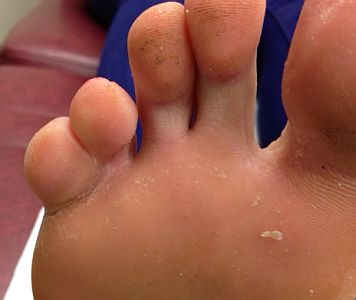 |
Query: Fissuring Under 4th and 5th Digits |
Do any of my colleagues have any other ideas that would stop this skin from cracking - whether it be a shoe appliance like a crest pad or something else?
06/13/2013
QUERIES (CLINCAL)
Query: Recurrent Ganglion Cysts
I am wondering what others do to minimize the chance of a ganglion recurring after surgical excision. I seem to have an unacceptably high recurrence rate particularly on midfoot and ankle ganglions. I carefully dissect the margins of the ganglion in an effort to prevent rupture prior to removal. If I identify a stalk (which is rare), I tie it off with non-absorbable suture and heavily cauterize it. More often than not, the ganglions seem to have a diffuse origination from a joint capsule which I will attempt to close and heavily cauterize.
I'm not sure what other steps I could take to minimize the chance of recurrence short of fusing the offending joint which seems too extreme. I have contemplated the thought of "patching" the area with a GraftJacket or other similar product in an attempt to scarify it and prevent refilling with fluid, but I have yet to try it. Thoughts?
06/12/2013
QUERIES (CLINCAL)
Query: Piezogenic Pedal Papules
Does anyone have information about the piezogenic pedal papules which are generally located in the rim of the heel? I am interested in sources of information, current treatment(s) used, if any, and reasons for their appearance.
Kel Sherkin, DPM, Toronto, Canada
06/01/2013
QUERIES (CLINCAL)
Query: Diabetic with Hemorrhagic Keratosis
I have a 41 year old active athletic male diabetic patient with hemorrhagic keratosis under the IP joints of both halluces. These were neuropathic ulcerations that took over a year to heal. They require debridement every two weeks to prevent re-ulceration. There are no visible IP sesamoids present. Surprisingly, the range of motion at both MPJs is excellent/unrestricted.
 |
Hemorrhagic Keratosis |
I am considering resections of the heads of the proximal phalanges. I am looking for comments from those who have experience with this, concerning whether patients' lesions resolved and the stability of the toes.
05/28/2013
QUERIES (CLINCAL)
Query: Dislocation of the Second Metatarsal Phalangeal Joint
A 48-year-old female patient presented to the office with extreme pain in her right forefoot. Her pain was located in the 2nd and 3rd MPJs. She was previously treated by other providers and her treatments consisted of multiple cortisone injections and orthotics. These treatments were initially successful, but left her with a plantar plate tear and dislocation of the 2nd MPJ. She began to have extreme pain after starting an exercise program which entailed walking on a treadmill approximately 30 minutes per day. On examination, she had capsulitis in the second and third MPJs.
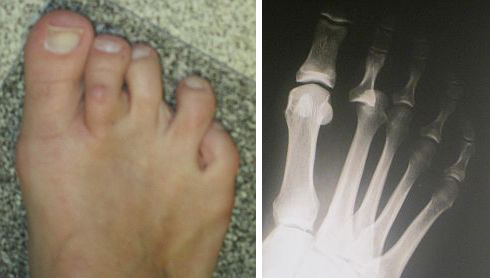 |
Dislocation of the Second Metatarsal Phalangeal Joint |
She has lots of deformity in her toes and has obvious dislocation of the second metatarsal phalangeal joint. The deformity was reducible with clinical manipulation. Her AP x-ray confirmed that her second toe was dislocated. How would you address this type of deformity?What is the average post-operative course with respect to post-operative pain for your patients?
Don Peacock, DPM, Whiteville, NC
05/16/2013
QUERIES (CLINCAL)
RE: Difficult Post-Trauma Case
Six weeks ago, my patient’s right foot sustained a triangular-shaped blunt trauma to the dorsum centered about the midshaft of the second met shaft. A matching triangular, mildly ecchymotic, area of swelling appeared soon after the trauma and remains; this triangular area and the immediate surround is hypalgesic. Initial x-rays were negative for fracture.
The triangular area of swelling continues to be as painful as the initial injury; this pain is mitigated by use of Xanax and Lidoderm patches that reduce the pain sufficiently to allow the patient to sleep. I did not prescribe opiates for fear that...
Editor's note: This extended-length letter can be read here.







